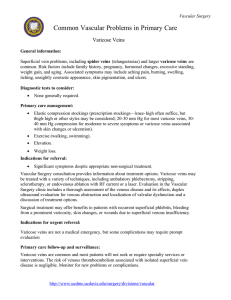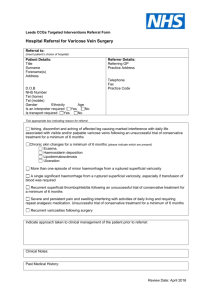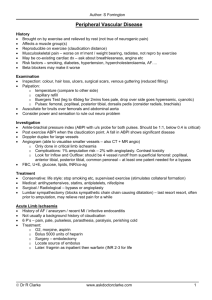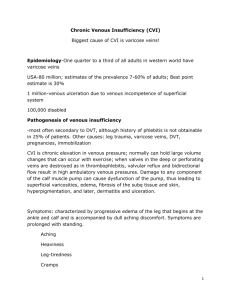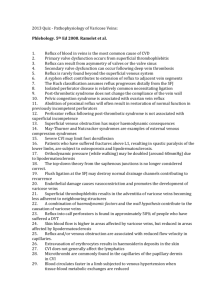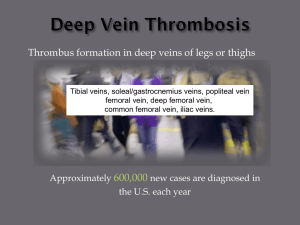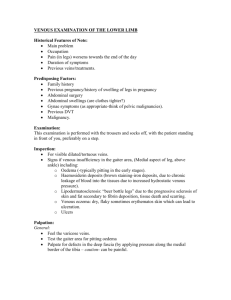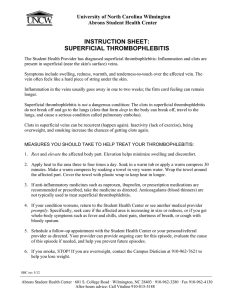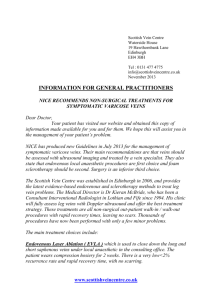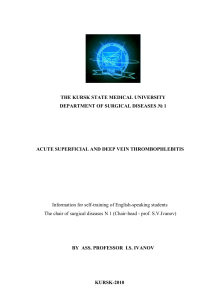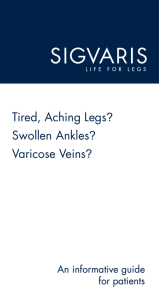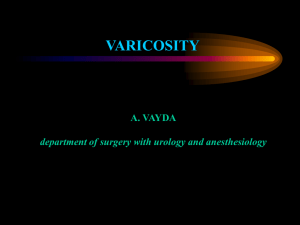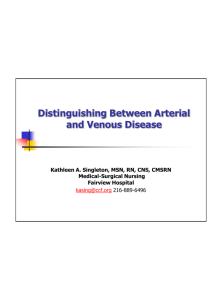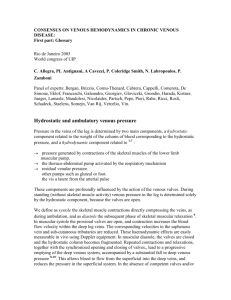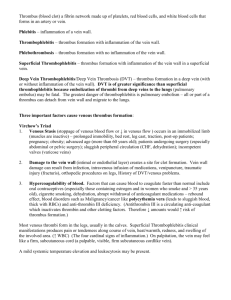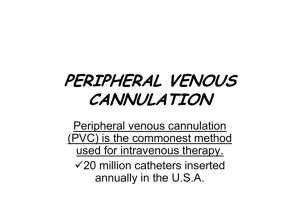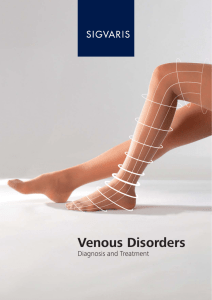Varicose veins
advertisement
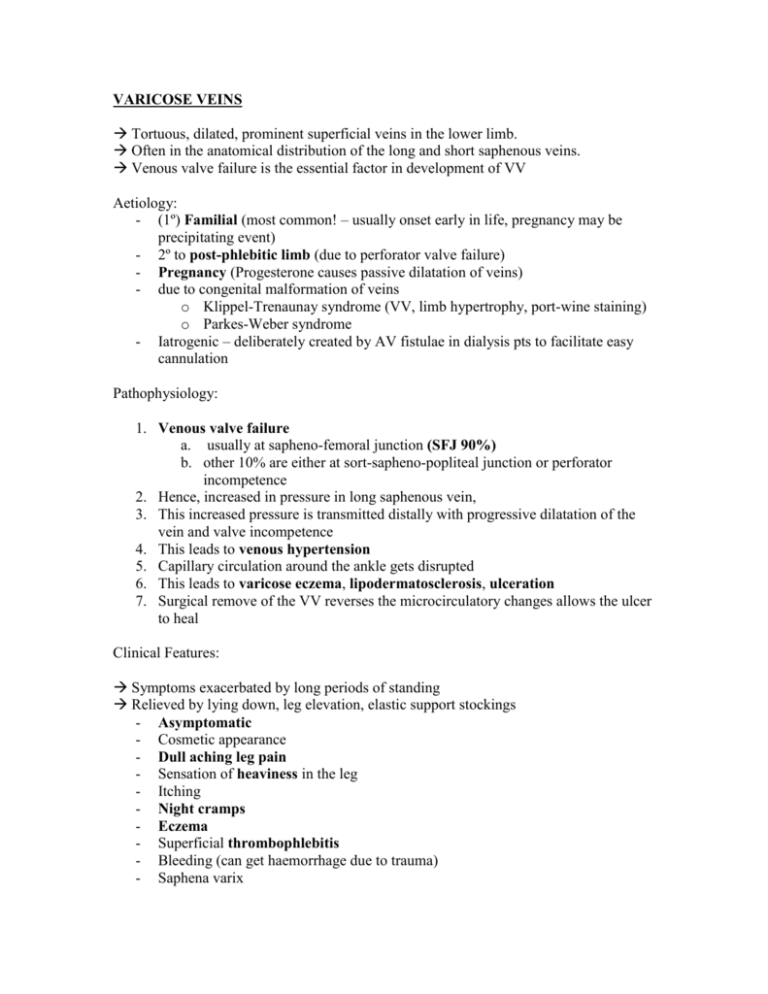
VARICOSE VEINS Tortuous, dilated, prominent superficial veins in the lower limb. Often in the anatomical distribution of the long and short saphenous veins. Venous valve failure is the essential factor in development of VV Aetiology: - (1º) Familial (most common! – usually onset early in life, pregnancy may be precipitating event) - 2º to post-phlebitic limb (due to perforator valve failure) - Pregnancy (Progesterone causes passive dilatation of veins) - due to congenital malformation of veins o Klippel-Trenaunay syndrome (VV, limb hypertrophy, port-wine staining) o Parkes-Weber syndrome - Iatrogenic – deliberately created by AV fistulae in dialysis pts to facilitate easy cannulation Pathophysiology: 1. Venous valve failure a. usually at sapheno-femoral junction (SFJ 90%) b. other 10% are either at sort-sapheno-popliteal junction or perforator incompetence 2. Hence, increased in pressure in long saphenous vein, 3. This increased pressure is transmitted distally with progressive dilatation of the vein and valve incompetence 4. This leads to venous hypertension 5. Capillary circulation around the ankle gets disrupted 6. This leads to varicose eczema, lipodermatosclerosis, ulceration 7. Surgical remove of the VV reverses the microcirculatory changes allows the ulcer to heal Clinical Features: Symptoms exacerbated by long periods of standing Relieved by lying down, leg elevation, elastic support stockings - Asymptomatic - Cosmetic appearance - Dull aching leg pain - Sensation of heaviness in the leg - Itching - Night cramps - Eczema - Superficial thrombophlebitis - Bleeding (can get haemorrhage due to trauma) - Saphena varix - Ulceration On examination: - - - - Examine standing Inspection: o Obvious varicosities in distribution of long/short saphenous veins o Pigmentation/ulceration around ankle o Telangiectasia (clumps of spidery superficial dilated venules) Palpation: o Veins feel tense on palpation o Saphena varix – dilatation adjacent to SFJ – cough may elicit thrill (cruveilheir sign), and an impulse might be felt if percuss vein distally Trendelenburg test o Lie patient down and elevate leg to drain veins o Put on tourniquet just below groin (ie occluding SFJ) o Stand up (with tourniquet on) o If veins stay empty (most patients) – means the incompetence is above the tourniquet – ie at SFJ o If veins refill rapidly – means incompetence is at short-sapheno-popliteal junction or an incompetent perforator vein (so need to do Duplex scan to assess for definite) Can also use Doppler to assess reflux (will hear two wooshes with reflux) Investigations: 1. Trendelenburg tourniquet tests – is incompetence at SFJ? 2. Doppler velocitomtry – is there reflux? 3. Duplex scanning! – best test, do if unsure about anything Management: - Non-pharm o Avoid long periods of standing o Elevate legs o Wear support stockings - Sclerotherapy o Good for small varicosities below knee o Sodium tetradecyl – produces superficial thrombophlebitis and occludes the veins o Follow with compression, and walk several miles a day o Problems: Anaphylaxis Ulceration Local reccurence - Surgical ablation o Vein stripped - Laser therapy?? Superficial thrombo-phlebitis local inflammation of a segment of superficial vein - Causes: o In varicose vein – usually non-infective o Iatrogenic – prolonged cannulation (esp after admin of dextrose, some Abx, contrast) - Vein feels like a cord, surrounding skin is red and tender - Thrombophlebitis migrans o Recurrent episodes of superficial thrombophlebitis o Think malignancy and collagen vascular disease - Non-infective thrombophlebitis does not require Abx or rest! – instead it needs local compression, analgesia, and gentle mobilization. Post-thrombotic (post-phlebitis) limb - Common sequel of a DVT Pathophysiology - Normal venous pressure at ankle is about 125 cmH2O ( = distance from diaphragm to ankle) - Normally this pressure falls to 30% of this on walking – calf muscle contraction pumps blood back to heart (supperfdeepheart), and valves prevent regurgitation - However, if these valves are incompetent, or if the deep system is occluded as a sequela to DVT, venous ankle pressure will remain elevated and will actually rise with calf compression - This produces venous hypertension - Continued back pressure on perf valves renders them incompetent - So get inefficient drainage of blood from superficial veins - So get secondary varicose veins - Then, by various mechanisms – fibrin leaking & hypoxic injury, white cell trapping and cytokine release, decreased fibrinolytic activity … - End up with varicose eczema, lipodermatosclerosis, and eventually venous ulceration - Also onychogryposis (sheeps horn nail) Clinical features: - May appear 2-30 years after a thrombotic episode (mightn’t even remember) - Venous eczema o above medial malleolus, due to haemosiderin deposition, indicates chronic venous stasis and red cell destruction in tissues - Lipodermatosclerosis o subcutaneous tissues are thicked and contracted around the ankle – inverted champagne bottle - - Venous ulceration o usually above medial malleolus o shallow, with sloping edges (if thickened edge in chronic ulcer – think malignant change – Marjolin’s ulcer) o base of ulcer – strawberry red granulation tissue, may be covered by slough o surrounding tissues – indurated and pigmented o Usually not painful/tender Occasionally – may get cellulites (think acute painful tender and hot leg) Elevation and compression is the mainstay of treatment! But first make sure there is no arterial insufficiency – check peripheral pulses, if can’t feel them do ABIs. In diabetic do toe pressures (vessel sclerosis at ankle gives false high reading, but the sclerosis doesn’t affect toe arteries.) - Four-layer bandaging Stanozolol (anabolic steroid) enhances fibrinolysis – for lipodermatosclerosis – doesn’t improve ulcer healing
